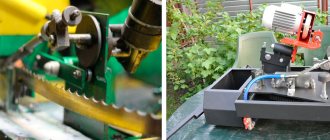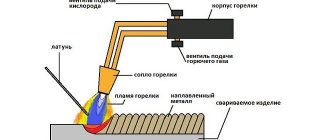Electrodes in our time do not belong to the category of scarce goods. In any hardware store, we can buy electrodes of any diameter and any purpose. Every craftsman always has some kind of supply of electrodes at home: three, four, etc.
Advertisement
But! Agree, there are times when, in the midst of work, the electrodes unexpectedly run out. Unpleasant. I didn’t think, I didn’t calculate, I didn’t stock up. It’s good if your neighbor is also a welder and can help out with a dozen other electrodes.
What if there is nowhere to get it? And the work needs to be finished!
This is what we’ll actually talk about.
I’ll say right away: I have two recipes for you. One of them is a miner's
The first recipe. How to make a welding electrode
This technology requires a lot of time and some materials (which, like normal electrodes, you may not have). Therefore, although this method exists, in my opinion... while you make these homemade electrodes... you can get hold of factory ones.
Nevertheless... In case you find it useful:
To make electrodes according to the first recipe, you will need:
- steel wire of the appropriate diameter (2, 3, 4, 5 or 6 mm.)
- liquid glass
- chalk or... paper
Mix 2 parts liquid glass with one part chalk. Dip the wire into a bath of this solution, leaving 3 centimeters of the surface uncovered (for fastening in the holder). Remove from the bath and hang on a wire to dry.
After a few minutes, when the solution begins to dry out a little, additionally “roll” your electrode in chalk.
Complete drying time is about 20-30 minutes. After this, you need to calcinate the electrode in an oven at a temperature of 110 degrees.
As you probably already guessed, you shouldn’t count on high technological performance from such a homemade product. You cannot make a high-quality seam with such an electrode. But if you are satisfied with working with tacks, this electrode is what you need!
Instead of chalk, you can use... paper! Soak ordinary newspaper in liquid glass and... wrap it around the wire in 5-6 layers. This option is considered more successful than the previous one. It is assumed that when the paper burns near the arc, the carbon dioxide released from the combustion will protect the molten bath from oxygen.
Heat or dry - what's the difference?
The calcination and drying procedures are similar in almost all respects. However, there are some minor differences. Calcination is carried out strictly according to the instructions presented on the packaging (as in the photo above).
The main purpose of drying is to remove moisture. Therefore, for this procedure it is not so important to strictly and seriously follow the recommendations. For your information! Many professional welders simply hold the electrodes on the radiator and this replaces calcination.
This is if you cook, for example, a bench or a gate. But when ships or pipelines are welded under pressure, then it is important to follow the technology. Thus, in some cases it is possible to use “folk” remedies for heat treatment. But to do this, you need to have information on how to dry electrodes at home. Information should be obtained from reliable sources and rely only on the opinions of experts. Basic explanations on how to dry electrodes at home are given below.
The second recipe. Shakhtyorsky. How to make an electrode.
This recipe is taken from a miner's environment. This is where there really is, in case of unexpected work, there is no place to get electrodes!!!
Miner's ingenuity sometimes gives birth to such technological solutions that you are amazed!
So... Take a wire of the required diameter and simply coat it... with ordinary clay! That's all! They don't even dry it. They work right away.
But there is one caveat. To weld with this electrode, direct current is required. I won’t tell you where they get direct current in the mine. Because this technology is associated with a gross violation of safety regulations. If there are miners among my readers, they will guess what I’m talking about.
Although, I’ll give you an outline. She is in this photo:
If you only need to cut metal, then use a conventional AC machine. This electrode is most often used for cutting. If you don’t have a factory one at hand, but the work needs to be done.
Like this!
Electrode wire
It is desirable that the wire be close in composition to the metal being welded.
Otherwise, there is a high risk that the seam will turn out to be short-lived and of poor quality. Otherwise it will completely fall apart. Today, 56 grades of electrode wire are produced. They all have different chemical compositions. They can be divided into three main groups.
The first group is carbon wire. It contains up to 0.12 percent carbon. This wire is used to weld low and medium carbon steel.
The second group is wire for welding low-alloy steel. It contains nickel, chromium, molybdenum, titanium, manganese and other chemical elements. Well, the third group includes high-alloy wire.
Special tables can help you choose the right type of wire. Based on the symbols contained in them, it is not difficult to calculate the appropriate chemical composition of the wire.
Electrode wire is available in diameters from 0.3 to 12 millimeters. Most often used with a diameter of three to six millimeters. The wire must always be clean.
Manufacturing instructions
It doesn't matter what brand of electrodes you need to purchase, in any case it is not cheap. Especially for beginner welders. We have found a solution to this problem and suggest you make the rods yourself. There are many videos on the Internet in which experienced craftsmen explain the technology for making materials for welding.
We also decided to share our instructions on how to make homemade electrodes with your own hands. Follow these simple steps:
- Prepare aluminum wire with a diameter of no more than 4 millimeters and cut it into rods 20-25 centimeters long. These parameters are usually sufficient, but you can change the diameter and length as you wish. Our base is ready.
- Now let's prepare the coating. Grind up chalk (preferably regular white) and mix it with silicate glue (sometimes called “liquid glass” in stores). Mix everything thoroughly until smooth and dip the aluminum rods into it.
- Make sure that the coating layer does not exceed 2 millimeters. Leave the electrodes to dry. When the coating hardens, the rod can be used for work.
Yes, such electrodes for resistance welding are inferior in quality to factory products, but they still allow you to perform simple work that does not require increased responsibility and a perfect seam. This instruction may seem too simple, but believe me, electrodes for spot welding on your own can also be effective and will absolutely save your money.
Please note that this is not a factory carbon electrode or zinc electrode, it is not European quality. So test your electrodes first before working on unwanted metal.
Electrode selection
When choosing conductive rods for welding aluminum, you need to pay attention to the following aspects:
- The composition of the electrode must correspond to the alloy of the elements being connected. Information about the first is indicated by the manufacturer on the packaging and certificate.
- The thickness of the consumable material should not exceed the thickness of the workpiece by more than 1 mm. Violating the rule will result in burning through the element.
- Welding rods dried more than once reduce the strength of the resulting bead. Welding is performed with carbon, graphite or tungsten electrodes, which is determined by the method of operation.
Several types of rods are used for welding operations with aluminum. The main ones are the following groups:
- alkaline-salt - OK 96.10, 20, 50, intended for aluminum and its technical category, due to increased hygroscopicity they need protection from humidity;
- OZAHA - provide a good indicator of weldability and the resulting bead on different metal alloys, you can weld not only horizontal, but also vertical seams;
- OZA - SvA1, 3, 5, 10, for pure aluminum and alloy with silicon;
- UAHA - aluminum alloys;
- tungsten - using a controlled protective atmosphere.
The main disadvantage of the latter is considered to be difficult arc ignition.
For simple welding operations, aluminum electrodes can be made in-house.
This will require the following supplies:
- Aluminum wire ± 30 cm long, 3-4 mm in diameter;
- A coating made from crushed chalk and liquid glass.
Apply the paste mixture evenly onto the wire in a layer of 1-2 mm. After drying, the electrode is ready for use.
DIY electrodes for welding aluminum
Aluminum electrodes for welding are metal rods coated with coating. The coating protects the metal from oxidation and improves the quality of the weld. They are practically not used in large workshops and factories, since their efficiency is not enough to perform large volumes of work. But such electrodes are widely used by home craftsmen.
A carbon electrode is often used to weld aluminum. In this article we will tell you everything you need to know about aluminum rods and explain in detail how to make your own welding electrodes.
Ways to dry and calcinate electrodes at home
The ingenuity of some welding specialists has led to the emergence of several effective methods for processing materials without the use of special equipment. We also recommend that you familiarize yourself with this material on how to calcinate.
The most popular and simple method is to improve welding rods by calcination in the oven .
This procedure includes several steps, after familiarization with which any novice welder will know how to calcinate electrodes in the oven:
- An electric is more suitable for drying than a gas oven. The gas contains a small amount of water , and heating cannot be done over an open fire ;
- you should preheat the oven to 200-250 degrees (or to the temperature written on the package);
- place the welding rods inside;
- close the door tightly;
- wait 1.5-2 hours;
- Turn off the device and allow it and the materials to cool gradually.
If a master needs to know how to dry electrodes at home, then he needs to familiarize himself with another “folk” method - heating the materials with a hair dryer .
To carry out this procedure, the welder will need a tool capable of producing temperatures up to 150 degrees, and a container (pipe) for loading materials. The electrodes are loaded into a pipe, the diameter of which must match the diameter of the device.
Hot air is directed into the container and the process continues as long as necessary for specific materials. On some hair dryer models, you can set the desired temperature.
If desired, you can install both a thermometer and a timer on the pipe to turn the hair dryer on and off.
True, this way we are already approaching the creation of a homemade stove.
Some skilled craftsmen build a furnace for calcining electrodes with their own hands:
- To do this, it is necessary to weld a frame from a profile pipe;
- the frame is “ sheathed ” on the outside with galvanized steel sheet, on the inside – with glass-magnesium sheet;
- Seal seams and joints with sealant;
- fill the space between the outer and inner layers with mineral wool, which will serve as a thermal insulation material;
- cover the LSU layer with mirror stainless steel;
- To prevent heat loss, it is necessary to place a silicone seal ;
- To load materials, you need to screw the corners inside the device and weld the grates .
- the oven for drying electrodes must also be equipped with a temperature sensor .
Self-built furnace for calcining electrodes
This scheme may allow some changes.
Please note! The quality of the above methods cannot be compared with the results shown by specialized equipment. For welding non-critical products, processing at home is also suitable. Because performing household welding does not require high performance from the metal of the weld, the appearance and quality of the finished product, most often, also does not play an important role.











